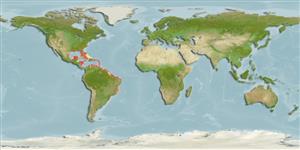Preferred temperature (Ref.
123201): 23.3 - 28.1, mean 27.1 °C (based on 764 cells).
Phylogenetic diversity index (Ref.
82804): PD
50 = 0.5000 [Uniqueness, from 0.5 = low to 2.0 = high].
Bayesian length-weight: a=0.00661 (0.00419 - 0.01042), b=3.03 (2.90 - 3.16), in cm total length, based on LWR estimates for this species & (Sub)family-body (Ref.
93245).
ຊັ້ນເຂດຮ້ອນ (Ref.
69278): 3.3 ±0.44 se; based on food items.
ຄວາມຢືດຢຸ່ນ (Ref.
120179): ສູງ, ປະຊາກອນຕຳ່ສຸດທີ່ໃຊ້ເວລາສອງໜ້ອຍກວ່າ 15 ເດືອນ (Preliminary K or Fecundity.).
Fishing Vulnerability (Ref.
59153): Low vulnerability (10 of 100).
Nutrients (Ref.
124155): Calcium = 144 [75, 312] mg/100g; Iron = 0.905 [0.440, 1.683] mg/100g; Protein = 18.7 [16.8, 20.3] %; Omega3 = 0.17 [0.07, 0.32] g/100g; Selenium = 20.8 [9.8, 50.5] μg/100g; VitaminA = 128 [35, 438] μg/100g; Zinc = 2.51 [1.66, 3.68] mg/100g (wet weight);
